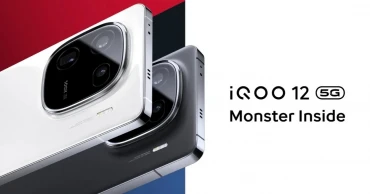UFS 4.0
vivo iQOO 12 Review: Flagship Killer or a Flagship Itself?
iQOO smartphones are known for their reliable performance at a marginal price. Their lineup is often dubbed as gaming on a budget. But the marginal price and the flagship killer tag come with certain corner cuts. But that all changed with their new release. iQOO launched the iQOO 12 on 14th November 2023. The device brings improvements in almost every sector compared to its predecessor. Now the question arises, is the vivo iQOO 12 a flagship killer or a proper flagship itself? Let’s find out.
Key Specs of the vivo iQOO 12
Design and Build Quality
It seems like iQOO has been inspired by OnePlus’s Never Settle philosophy when it comes to design. Gone are the rectangular camera housing which has been replaced with a rather square-ish round look. iQOO calls it the porthole design.
The build quality feels more sturdy thanks to the aluminum frame and glass back composition. The dimension of the iQOO 12 comes in at 163.22 mm by 75.88 mm by 8.10 mm (Alpha and Legend) or 8.35 mm (Desert Red). The weight of the device also differs as Alpha and Legend comes in at 203.7 g and the Desert Red comes in at 198.5 g. iQOO has partnered with BMW for the Legend variant. It adds a distinct dash of the M series colorways in a white AG Fluorite back.
Read more: Infinix Note 40 Pro Review: A Mid-Range Phone with 108P sensor, MagSafe Charging
Ports and buttons are in their usual space as before. The 12 with its updated looks and build quality seems to be on par with most flagships today. The Chinese variant even has IP64 water and dust resistance. However, it couldn’t be confirmed whether it’s the same for the global variant as well.
The Display
The display on the iQOO 12 is a 6.78-inch LTPO AMOLED 8T panel with 1B colors, 144Hz refresh rate, HDR10+, 1400 nits of HBM, and 3000 nits of peak brightness. The resolution of the panel comes in at 1260 by 2800 pixels at a 20:9 aspect ratio. It brings the pixel count to about 452 ppi.
One of the impressive things about the iQOO 12 is the ultra-slim symmetric bezel on all sides. It takes the screen real estate to 89.6% screen-to-body ratio.
Read more: Samsung Galaxy M55 Review: Here’s What It Offers
The display also has a 2160 Hz PWM dimming mode for ease of usage in ultra-low light conditions. iQOO also incorporated an intelligent anti-fatigue brightness strategy and low blue light emission to relieve the stress on the eyes.
The overall experience with the host of features has been excellent. The display is fast, accurate, has great colors, and is simply a pleasure for content consumption.
The Camera
The camera on the iQOO 12 got a massive improvement over last year’s 11. There’s a new triple camera setup with the main sensor being a 50 MP f/1.7 23 mm wide angle lens with PDAF and OIS. There’s also a 64 MP f/2.6 70 mm periscope telephoto lens and a 50 MP f/2.0 119 degrees ultrawide lens. There’s also a 16 MP f/2.5 selfie shooter on the front.
Read more: ZTE Nubia Red Magic 9 Pro Plus Review with Pros and Cons
The flagship-grade sensors also provide impressive results. Pictures taken during the day had great contrast and sharpness to them with decent dynamic range. You might notice a slightly warm tone in a typical vivo fashion. Pictures taken at night were on par with daylight images thanks to the night mode. The front camera also took decent selfies. However it lacked details and sharpness compared to the main sensor.
The videography on the iQOO 12 is rated to be 8K at 30fps, 4K at 24/30/60fps, and 1080p at 30/60/120/240fps. Both the EIS and OIS do a great job of stabilizing and providing good-quality videos. The selfie shooter can capture only 1080p videos at 30fps.
1 year ago
realme GT5 Pro Review: High-performance or Hype?
In a bold move into the high-end market, realme introduces the GT5 Pro as a "dual-engine flagship," emphasising both impeccable performance and exceptional imaging capabilities. Launched on 16th December 2023, this smartphone aims to redefine realme's reputation in mid-range segments. From its robust design to impressive hardware, GT5 Pro marks realme's foray into the premium smartphone arena. This review explores every facet of the GT5 Pro.
Key Features and Specifications of realme GT5 Pro
Design
The realme GT5 Pro comes with a curved screen. The screen minimises borders (1.36mm on the sides, 1.94mm at the bottom). Weighing 218 to 224g, this device’s dimensions are 161.7mm by 7.51mm by 9.2mm.
The phone's quality is evident in its materials, featuring a super hard aluminium middle frame with 43% higher yield strength than standard titanium alloys.
The camera module features a champagne gold aluminium alloy ring. Its USB Type-C port supports fast charging. Notably, it lacks a headphone jack, embracing wireless audio trends.
Read more: iQoo 12 Pro Review: Flagship phone for gamers
The dual-SIM tray supports nano-SIM cards, but there's no microSD card support. An infrared port enables the phone to function as a remote control. With an IP64 rating, the GT5 Pro resists dust and water splashes, enhancing durability for outdoor use.
This device is available in several colour variants, such as, Black, White, and Orange. White and Orange options feature nano-leather, while the Black variant uses AG glass for a classic look.
Display
The realme GT5 Pro boasts a 6.78-inch screen that strikes a balance between ample viewing space and handheld comfort, catering to various activities like browsing, gaming, and multimedia consumption.
The screen utilises BOE's S1 flexible screen technology, with a resolution of 2780 by 1264 pixels (1.5K), ensuring sharp and detailed visuals without excessive battery drain.
Read more: vivo X100 Pro Review: A New Standard for Camera
In terms of colour accuracy, the GT5 Pro delivers quite natural colours, particularly noticeable in high-resolution photos or videos. The display's peak brightness is about 450 nits and ensures visibility in bright outdoor conditions. The manual maximum brightness is 1000 nits, with a global maximum of 1600 nits, beneficial for HDR content and detailing in various lighting conditions.
The 144Hz high refresh rate enhances user experience, especially in fast-paced gaming, with adaptive adjustment from 0.5Hz to 144Hz using 8T LTPO technology, optimising performance and power consumption.
For eye comfort, the GT5 Pro features 2160Hz high-frequency PWM dimming at low brightness, minimising screen flicker and eye strain. At higher brightness, it switches to DC dimming, reducing the risk of eye discomfort. The low SVM (Screen Flicker Metric) value of
1 year ago
Xiaomi Redmi K70 Review: Mid-range phone with flagship features
On November 29th, 2023, Xiaomi unveiled three new devices, including the Redmi K70. This device appears as a worthy successor to the Redmi K60, boasting several enhancements over its predecessors. Xiaomi has managed to deliver notable improvements in K70 while keeping its price at a mid-range level. Let’s take a look at the key specs, pros, cons, and price of the Redmi K70.
Key Features of Xiaomi Redmi K70
Design
The Xiaomi Redmi K70 combines a sleek and lightweight design, weighing 209g and measuring 160.9 mm by 75 mm by 8.2 mm. The dual Nano-SIM capability enhances network flexibility, catering to diverse user needs. The subtle design changes include a modified photo module block, a distinct texture on the glass panel, and a reduced steel size relative to the display frame.
The plastic edging, while maintaining durability, reflects cost-saving measures. The device's thickness stands at 8.2mm, contributing to its ergonomic feel in hand. Although lacking weather-sealing for splash resistance, the Redmi K70 impresses with a manageable weight, compact dimensions, and a volumetric capacity of 98.95cm³, making it a practical and stylish choice for users seeking a balanced smartphone experience.
Read more: Most Hyped Smartphones Releasing in December 2023
Display
The Xiaomi Redmi K70 impresses with a visually stunning 6.67-inch OLED screen, boasting a 1440 by 3200 pixels resolution that ensures intricate details in visuals. With a 120Hz refresh rate, the display delivers seamless and fluid motion across various media, enhancing the overall user experience.
Notably, the screen achieves an industry-leading peak brightness of 4000 nits, setting a new standard for comfortable viewing even under bright sunlight. The incorporation of an AI algorithm elevates the display further by upscaling select apps and video games, ensuring crisp and vibrant visuals. The technology behind the screen includes OLED/AMOLED, offering vibrant colors.
With a pixel density of 526 ppi, the Redmi K70 ensures clarity and sharpness in image rendering. The support for HDR10 and HDR10+ technologies, along with Dolby Vision, enhances color depth and contrast for a lifelike visual experience. The inclusion of features like an always-on display and a touch sampling rate of 480Hz adds to the device's appeal, making the Redmi K70 a standout choice for those seeking a top-tier display in a smartphone.
Cameras
The Xiaomi Redmi K70 boasts an impressive camera setup, featuring a 50MP primary sensor with an f/1.6 aperture and 1/1.55-inch size for exceptional image quality. The main sensor is equipped with Optical Image Stabilization (OIS), ensuring steady videos and sharp photos even in dynamic conditions.
Read more: itel A70 Review: A standard entry-level phone
Complementing this, the 8MP ultrawide lens and 2MP macro sensor enhance versatility, enabling users to capture a wide range of scenes with detail and clarity.
The front camera sports a 16MP sensor, perfect for high-resolution selfies.
Noteworthy features include built-in optical image stabilization, continuous autofocus for video recording, and phase-detection autofocus for photos, ensuring sharp and clear shots.
With the main sensor, this device can shoot 8K footage at 24fps, 4K videos at 24/30/60fps, 1080p videos at 30/60/120/240/960fps, and 720p footage at 1920fps. It has a gyro-EIS feature.
The front camera is capable of capturing 1080p videos at 30/60fps with gyro-EIS.
The inclusion of slow-motion video recording, dual-tone LED flash, HDR mode, and manual exposure settings further elevate the camera capabilities, making the Redmi K70 a reliable choice for photography enthusiasts seeking diverse and high-quality imaging experiences.
Read more: Google Pixel 8 Pro Review: Is this the best Android phone of 2023?
Performance and Software
The Xiaomi Redmi K70 is powered by the Snapdragon 8 Gen 2 4nm processor, offering robust performance for games and applications, despite being one generation behind the latest Qualcomm chip. Its graphic section is equipped with GPU Adreno 740.
Paired with up to 16GB of LPDDR5X RAM, the device excels in handling resource-intensive tasks and ensures smooth multitasking.
With internal storage options reaching up to 1TB of UFS 4.0 storage, the Redmi K70 provides ample space for fast data transfers and extensive file storage.
Running on Android 14, the device introduces advanced privacy features, including clipboard warnings, location privacy options, and camera/microphone privacy controls. Additionally, users can enjoy theme customization, personalizing their devices according to their preferences.
The Redmi K70's hardware specifications, coupled with the latest Android version, promise a seamless and feature-rich experience for users, making it a compelling choice in the smartphone market.
Read more: realme GT5 Review: A gaming phone with high capability
Battery and Charger
The Xiaomi Redmi K70 is equipped with a non-removable Li-Po 5000 mAh battery, ensuring a reliable power source for extended usage. What sets it apart is its exceptional charging capability, supporting a blazing-fast 120W wired charging system.
With PD3.0 and QC3+ compatibility, the device boasts an advertised 100% charge in just 18 minutes. This impressive charging speed adds convenience to the user experience, addressing power needs swiftly and efficiently, making the Redmi K70 a compelling choice for those seeking a quick and reliable charging solution.
Pros and Cons of Xiaomi Redmi K70
Pros
- Sleek and lightweight design- Up to 16GB RAM, up to 1TB storage- Android 14 with privacy features- 120W wired charging- 8K video footage.
Read more: OPPO Find N3 Review: A New Standard for Foldable Smartphones
Cons
- Lack of weather-sealing- Plastic edging- Specific wide aperture details not provided
Price of Redmi K70
The Xiaomi Redmi K70 is priced at CNY 2499 in China, which translates to BDT 38786 in Bangladesh. The conversion rate between Chinese Yuan (CNY) and Bangladeshi Taka (BDT) is CNY 1 = BDT 15.52. So, if you're considering the cost in Bangladesh, it would be BDT 38786 based on the current exchange rate.
Summing Up
Redmi K70 with a well-balanced package with a sleek design, robust RAM, a powerful processor, and a smart display. The camera setup is also decent. One of the most remarkable features is 120W wired charging, promising a full charge in just 18 minutes. Its 8K video recording is also impressive. However, the device lacks weather-sealing and comes with plastic edging.
On the whole, Redmi K70 is a compelling choice for users seeking a feature-rich smartphone at a competitive price point. It won’t be overwhelming to say that Xiaomi Redmi K70 is a contender for the best mid-range smartphone of 2023.
Read more: vivo X100 Review: The Flagship Killer of 2023
2 years ago





